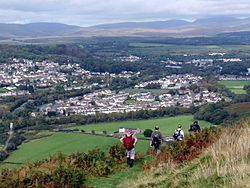Ystalyfera
| Ystalyfera | |
| Glamorgan | |
|---|---|
 Ystalyfera from Y Farteg | |
| Location | |
| Grid reference: | SN767089 |
| Location: | 51°45’50"N, 3°47’10"W |
| Data | |
| Population: | 3,019 (2011[1]) |
| Post town: | Swansea |
| Dialling code: | 01639 |
| Local Government | |
| Council: | Neath Port Talbot |
| Parliamentary constituency: |
Neath |

Ystalyfera is a former industrial village in the upper Swansea Valley in Glamorgan adjacent to the border with Brecknockshire. It is situated on the River Tawe, about 13 miles north-east of Swansea. National Cycle Route 43 passes though the village.
History
The history of Ystalyfera begins with a small farming family who shared the land. This is reflected in the village's name, composed from the Welsh-language words, Ynys (meaning island), tal, (meaning tall) and Berran (A Composite of Ber and Rhan, which indicates a land-share). A short piece of shared land (probably between agricultural labourers). The history of the name can be seen as it evolved through the ages: -
- 1582 Ynys Tal y Veran
- 1604 Tir Ynystalverran
- 1797 Stalyfera Issa, Ycha, Genol
- 1831 Ystalyfera
Ystalyfera grew as a village with the advent of coal mining and iron working, which were a huge part of everyday life in the local communities of the Swansea Valley.
In 1838 a furnace was built by James Palmer Budd at Ystalyfera and from this grew the iron and tinplate works which by 1863 was described as 'the largest tinplate manufactory in the world'. A new cold-blast process was successfully introduced here and, despite some early crises, the works prospered. By the mid-1850s there were forty furnaces for puddling and balling in operation and sixteen tin mills and houses. The output of iron increased from the 4,893 tons of 1843 to 29,828 tons in 1858. The works continued to grow during the 1860s and reached peak production in 1872 with the sale of 182,000 boxes of tinplate.
By this time, however, the years of prosperity were numbered. The 1870s witnessed little further addition to the plant of the works. Steel had now come to challenge iron on a larger scale, new methods of production demanded the energy, technical skill and capital which the ageing J. P. Budd at Ystalyfera could not supply. The works continued to operate during the eighteen-seventies, but with Budd's death in 1880 the end was in sight. By this time the works were incurring heavy losses and late in 1885 the works finally closed. For more than forty years the works had been the colossus of the district and, more than anything else, had been responsible for the transformation of the latter's economic basis and social structure. Less significant in their contribution were the two ironworks, at Pontardawe and Brynamman, though both became substantial producers of tinplate from the 1860s.
The expansion in iron production inevitably created a heavy demand for local coal. The middle decades of the 19th century saw the expansion of existing mines and the sinking of new ones in the parish and the neighbouring districts.
With the closure of the iron works and later the coalmines, Ystalyfera suffered very heavily on the economic front. Through the 20th century, the village rebuilt and redefined its role. At present, there are various small businesses that run in the village, though most of the village's inhabitants commute to nearby Swansea or Neath to work.
Present
Ystalyfera is home to Ystalyfera RFC – a rugby union club, which is an integral part of the village – and a cricket team. The village was home to two cinemas, as well as one just outside the boundary, which were all later demolished.
Ystalyfera is also the home to the Wern Fawr public house, and its famed Bryncelyn Brewery. The Brewery on site produced the Champion Beer of Wales in 2002/3 and 2003/4, coming 3rd in 2004/5. All of the beers produced have a Buddy Holly theme.